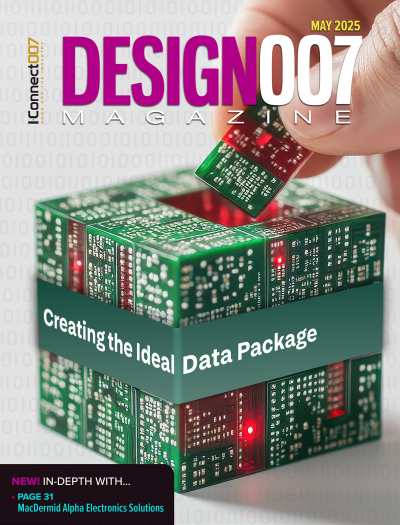-

- News
- Books
Featured Books
- design007 Magazine
Latest Issues
Current Issue
All About That Route
Most designers favor manual routing, but today's interactive autorouters may be changing designers' minds by allowing users more direct control. In this issue, our expert contributors discuss a variety of manual and autorouting strategies.

Creating the Ideal Data Package
Why is it so difficult to create the ideal data package? Many of these simple errors can be alleviated by paying attention to detail—and knowing what issues to look out for. So, this month, our experts weigh in on the best practices for creating the ideal design data package for your design.

Designing Through the Noise
Our experts discuss the constantly evolving world of RF design, including the many tradeoffs, material considerations, and design tips and techniques that designers and design engineers need to know to succeed in this high-frequency realm.
- Articles
- Columns
Search Console
- Links
- Media kit
||| MENU - design007 Magazine
3D Convergence of Multiboard PCB and IC Packaging Design
July 18, 2018 | Bob Potock, ZukenEstimated reading time: 3 minutes
The electronic product design process is being challenged like never before, with the need to develop feature-rich, light, compact products at a lower cost, in less time. To address these challenges, designers are combining chips and boards in new configurations, such as complex 3D stacked structures, or new packaging technologies like package-on-package (PoP) and system-in-package (SiP). They are also embedding passive and active components on inner layers, inside cavities and within the dielectric of the board stack-up.
Traditional 2D PCB design systems are used to design one PCB at a time in isolation from the other PCBs within a product, and also in isolation from the ICs, packages, and enclosure. Validating connections between the PCBs, collision checking the boards to the enclosure, and reducing interconnection distance to the ICs requires time-consuming manual operations that are error-prone and limit the potential for reuse.
A new generation of 3D multiboard product-level design tools offer major improvements by managing multiboard placement in both 2D and 3D, and enabling co-design of the chip, package and board in a single environment. Multiboard design makes it possible to create and validate a design with any combination of system-on-chips (SOCs), packages, and PCBs as a complete system. Chip-package-board co-design enables designers to optimize routability via pin assignment and I/O placement to minimize layer counts between the package, chip and board. The new design methodology makes it possible to deliver more functional, higher performing and less expensive products to market in less time.
Multiboard Design Challenges
Today’s complex multiboard electronic products create design challenges, such as planning and management of interconnects at the system level. In current-generation tools, the signal verification process for a multiboard design involves exporting pin lists that include net names for each board connector and correlating the net names to the master list of net names. In many cases, it’s also necessary to manually verify each board connector’s signal name. With mechanical engineers and board designers working with disconnected systems it’s difficult, if not impossible, to intelligently manage connectivity and changes between boards. Using a spreadsheet or some other disconnected document to manage the large number of interconnects between the PCBs in the system is time-consuming and prone to error.
When mechanical engineers have inaccurate information on the electrical design or electrical engineers have inaccurate information on the mechanical design, the result in many cases is that batteries don’t fit, mounting screws create shorts against PCBs, and connectors don’t mate with packaging openings. Improper management can easily result in wasted product development time, scrapped boards and slipped schedules.
The combination of increasing capabilities, shrinking size and more complex external shapes means that electronics must increasingly consider the shape of the package while the mechanical design is more dependent than ever on the physical aspects of the internal electronics. Multi-board designs make ECAD-to-MCAD translation more difficult because of the need to communicate the position of connectors and other common points between the boards.
Yet in the current generation of tools, the collision-checking process involves exporting placement information, usually in IDF format, for each PCB to a mechanical engineer for assembly analysis. PCB design tools have continued to focus on working in 2D on one PCB at a time, with the electrical work done in 2D and then the 2D design being exported into 3D mechanical design software where the boards are positioned and checked for interference. The PCB designer is unable to, for example, position two boards on top of each other to see how they fit together. This is normally done after the board design has been exported to the mechanical design tool. Interdependencies between interlocking boards and their enclo-sure in complex products are critical.
To read this entire article, which appeared in the June 2018 issue of Design007 Magazine, click here.
Suggested Items
Zuken Autorouters Embrace Collaborative AI
06/12/2025 | Andy Shaughnessy, Design007 MagazineMaybe you’ve never liked autorouters; if so, you’re not alone. As Andy Buja, Zuken’s technical account manager for PCB Solutions, admits, autorouters are not perfect. But today’s autorouters allow designers a greater level of control than ever before, especially routers that incorporate collaborative AI.
Bridging the Knowledge Gap in Test: A Conversation with Bert Horner
06/11/2025 | Barry Matties, I-Connect007Bert Horner is a seasoned industry veteran and co-creator of The Test Connection, Inc. (TTCI), a test and inspection company spanning over 45 years. In this candid conversation, Bert reflects on the challenges our industry faces with the retirement of career professionals and the subsequent loss of critical tribal knowledge. As he unveils The Training Connection’s innovative training initiatives, Bert emphasizes the importance of evolving educational programs that align with industry needs, particularly in design for test (DFT), and sheds light on strategies being implemented to foster the next generation of engineers.
The Shaughnessy Report: Planning Your Best Route
06/10/2025 | Andy Shaughnessy -- Column: The Shaughnessy ReportDesigners don’t like autorouters, period. In my 26 years of covering PCB design and EDA tools, I’ve met about 25 designers who admit to using autorouters regularly. Two of these, Barry Olney and Stephen Chavez, have articles in this issue. If experts like these use routers, why haven’t you tried one?
KYZEN Focuses on Aqueous Cleaning and Stencil Cleaning at SMTA Ontario
06/09/2025 | KYZEN'KYZEN, the global leader in innovative environmentally responsible cleaning chemistries, will exhibit at the SMTA Ontario Expo and Tech Forum, scheduled to take place Tuesday, June 17 at the Venu Event Space in Vaughan, Ontario, Canada. KYZEN will be on-site to provide information about aqueous cleaning chemistry AQUANOX A4618 and the full line of AQUANOX products.
All About That Route: Design007 Magazine June 2025
06/09/2025 | I-Connect007 Editorial TeamDo you prefer manual routing or autorouting? Maybe you’re one of the designers who performs manual routing with an autorouter. Most designers favor manual routing, but today's interactive autorouters may be changing designers' minds by allowing users more direct control. In this issue, our expert contributors discuss a variety of manual and autorouting strategies.


